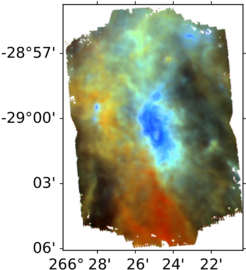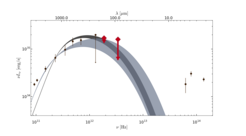Far-Infrared Emission from Sgr A*

The emission stemming from the immediate surroundings of the Galactic Center Black hole Sgr A* has been observed in many parts of the electromagnetic spectrum. At wavelengths longer than 5 µm the earth's atmosphere is becoming increasingly in-transparent, which makes earth-bound far-infrared observations impossible. For this reason, we use the MPE built camera PACS on board the Herschel space telescope to observe the Galactic Center at 100 and 160 µm in von Fellenberg et al. 2018. Our observations reveal in unprecedented spatial resolution a warm dust structure, which warps around central region of the milkyway, the Circum Nuclear Disk (CND).
However, the bright emission from the CND complicates observations of the black hole: The faint emission from the electrons in the accretion flow of Sgr A* are completely outshone by the CND rendering a direct detection impossible. In order to reveal the black hole, we make use of a trick called differential photometry: The bright thermal emission from the CND is constant, whereas the emission of black hole's accretions flow varies in time. We thus subtract the median images of our observations and correct several artifacts which then reveals the variable flux of the black hole. This allows us to obtain the first upper and lower limits on spectral energy distribution (SED) at 160 and 100 µm.

Comparing the updated SED with the emission from simple one zone models of the accretion flow, we find that solutions with broad peaks better match the modern sub-mm and far infrared observations. Such broad solutions have a higher electron temperature (Te ≈ 1011K) than previously thought and are mostly optically thin at 230 GHz. In contrast to the more pointed older models (e.g. Yuan et al. 2003, Dexter et al. 2010), the peak at 1-3 THz is set by the critical frequency of synchrotron emission and not the transition from optically thin to optically thick synchrotron emission. This sets an interesting stage for the upcoming direct imaging efforts of the EHT collaboration, which aim at resolving the event horizon scale structure of the Galactic Center Black Hole Sgr A*.

